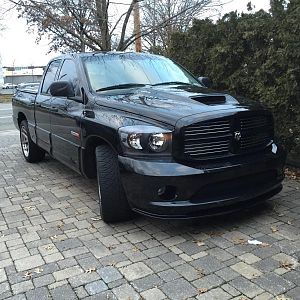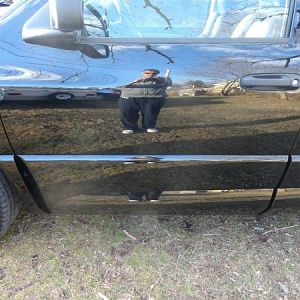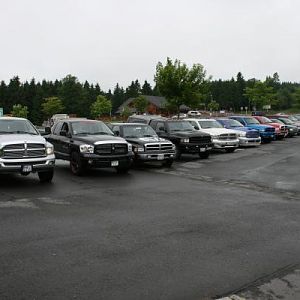James, I'm not famolaiar with mini verde --appears to have come about near the end of my golf course days...
I was in Dallas and we grew Bent Grass, what a pain in the ass that was to keep alive in the dallas summer....Here is awrite up by Keith Ihms,Bent Tree Country Club in Dallas, Texas. He is one of the best in the dallas area..Very High end course....I don't no for sure but this makes me wonder if they switched from BentGrass to Mini Verde on his course.
[SIZE=-1]Tight, Uniform Canopy, Resulting in an Excellent Putting Surface [/SIZE]
[SIZE=-1]"MiniVerde is one of several varieties planted in the Spring of 1998 on the USGA test green here," states Keith Ihms, golf course superintendent at Bent Tree Country Club in Dallas, Texas. [/SIZE]
[SIZE=-1]"After two growing seasons, I have been very pleased with the growth habits of MiniVerde. We've experienced fewer issues of over-thatching and it is producing a truer putting surface than some of the other varieties we're testing." [/SIZE]
[SIZE=-1]"MiniVerde's stolon growth pattern appears to me to be deeper into the soil and its root system more aggressive which should mean it will handle the winter months better than several of the other varieties," he said. [/SIZE]
[SIZE=-1]"We also planted MiniVerde in a fairly high trafficked area, and I'm pleased with how it responds - it's really held its own. I'd encourage any superintendents considering planting MiniVerde to come by and take a look at our test green - here they can observe its performance under real conditions... touch it... putt on it... and see for themselves." [/SIZE]
[SIZE=-1]- Keith Ihms [/SIZE]
MORE INFO;
Ultra Dwarf Bermudagrass for Golf Greens
MiniVerde is a high shoot density, stoloniferous bermudagrass for production of high quality golf greens. MiniVerde tolerates continuous close mowing, has a dark green genetic color and excellent low temperature color retention. MiniVerde does not exhibit purple leaf coloration due to anthocyanin production typical of Tifdwarf bermudagrass exposed to low, non-freezing temperatures.
In mild climates, such as within 100 miles of the Gulf of Mexico, MiniVerde may make sufficient growth through the winter months so that overseeding is not required to provide an attractive winter color. Miniverde is adapted for use on native soil and high-sand content golf greens.
MiniVerde will tolerate relatively high amounts of sodium and therefore is adapted for use with reclaimed water. MiniVerde also tolerates soil pH levels of from 5.5 to 9.0 but will perform best at pH 6.0 to 6.5. MiniVerde has few pest problems and tolerates close, frequent mowing.
Grow-In Management Strategies
Putting surface development will depend on rate of planting and fertilization during the first weeks after planting. When resurfacing existing greens, a well prepared planting bed should be achieved. Complete kill of existing grass surfaces should be accomplished by fumigation or by repeat applications of non-selective herbicides. Excess organic matter residues at the soil surface should be removed after herbicide application and prior to planting and planting bed preparation. Planting rates typically range from 15 to 30 bushels per 1000 sq. ft. Higher planting rates will usually allow opening greens for play more quickly.
Soil tests should be obtained before soil preparation and planting to determine nutrients that may be inadequate for good plant growth. Fertilizers should be incorporated during soil preparation to correct any nutrient deficiencies. A slow release nitrogen fertilizer should be used to supply 1 to 2 pounds of N per 1000 sq. ft. at planting. After planting, nitrogen should be applied every 5 to 10 days using a soluble nitrogen carrier such as urea, ammonium nitrate, or ammonium sulfate, to maintain maximum growth. Frequency and amount of nitrogen fertilizer application should be reduced as the MiniVerde canopy approaches full closure. Also, additional applications of macro and micronutrients may be needed during grow-in.
Irrigation should be applied to sprigs immediately after planting. Sprigs should be planted in moist soils or root-zones. Hand watering using a syringe type nozzle during planting can speed application of water until planting crews move offsite and overhead irrigation is initiated. Initial overhead irrigation should thoroughly saturate the upper 1 to 2 inches of the soil profile. Irrigation should be programmed to operate 4 to 8 times a day for short cycles depending on temperature and humidity. Newly planted sprigs must be kept moist for the first 7 days to prevent dessication and heat injury on hot days. After sprigs develop 1 to 2 inch new roots, irrigation can be gradually reduced.
Mowing should begin as soon as the sprigs stabilize the soil surface. A carefully adjusted, well-sharpened walk behind mower should be used with an initial bench height setting of 0.20 to 25 inch. The rear roller of walk-behind reel mowers will help smooth the surface. Mowing should begin within 7 to 14 days after planting. Mowing 3 to 4 times per week is usually adequate during the first two weeks of mowing. As the canopy reaches full closure, mowing height should be gradually reduced to the desired mowing height along with daily mowing. Typical MiniVerde golf green mowing heights will range from 0.10 to 0.125 inch bench settings at 6 to 10 weeks after planting. Actual mowing heights will be determined by factors such as golfer demands, traffic, amount of contours on greens, and speed of grow-in. Light, grooming or vertical mowing can also be used as the canopy reaches full closure to help smooth the surface and reduce grain.
Topdressing, using material consistent in physical characteristics to the existing root-zone, should be applied to newly planted greens to help produce a smooth putting surface. Light, weekly (about 0.02 inch) topdressing applications should begin 2 to 3 weeks after planting depending on rate of surface development.
The process of planting and growing in newly planted golf greens often produces an organic layer at or near the soil surface. The thickness and depth of this organic layer will depend on sprigging rate and amount of topdressing applied during grow-in. Such an organic layer is common to all bermudagrass and even bentgrass golf greens. If untreated, this layer will affect water infiltration and air exchange; both of this factors will limit root development as golf greens mature. Core aerification is a turf cultural practice required for management of all high quality putting surfaces. After grow-in, new greens should be evaluated for the presence of a surface or near surface organic layer. If present, a core aerification or other suitable cultivation program should be initiated to correct this problem. This practice may be needed prior to opening greens for play. The use of small diameter hollow tines will begin the process of eliminating surface layers without causing severe surface disruption.
Long-Term Management Strategies
Thatch accumulation is a concern in the management of all bermudagrass and bentgrass golf greens. The superior shoot and stolon development of MiniVerde may contribute to rapid thatch accumulation unless a well designed and implemented cultural strategy is used. The cultural program for MiniVerde should focus on maintaining a fast, smooth putting surface while retaining an aesthetically pleasing appearance.
Plant Nutrition
Application of all nutrients except nitrogen should be based on soil tests. Plant tissue analysis may be used to fine-tune nutrient management programs. After grow-in, nitrogen applications should be reduced dramatically. Minverde is very responsive to nitrogen applications and will produce excess growth and thatch as nitrogen applications increase. The best long-term performance of MiniVerde has been observed at 6 pounds of N per 1000 sq. ft annually. This is approximately half the nitrogen required by Tifdwarf on an annual basis.
A successful nitrogen fertility program for MiniVerde should include the application of 4 to 5 pounds of N per 1000 sq. ft. annually using a granular slow release nitrogen carrier, such as a greens grade polymer coated urea, sulfur coated urea, or other nitrogen carrier possessing a similar mechanism of nitrogen release. Additional applications of quickly available nitrogen in small amounts should be applied in dry or liquid form only as needed for growth and color. Total annual nitrogen applications should not exceed 8 pounds of N per 1000 sq. ft. Foliar fertilization of MiniVerde can be successful as long as the total plant nutrient needs are met.
Exceeding 6 to 8 pounds of nitrogen per 1000 sq. ft. per year may improve color and density of MiniVerde in the short-term but can have devastating effects on putting quality, performance, and persistence in the long-term. Increasing N to amounts greater than 6 lbs per year can improve shoot density but will usually decrease green speed (Figure 1). Continued application of N greater than 6 lb annually will cause excessive thatch accumulation and will eventually result in substantial reductions in shoot density.
Mowing
MiniVerde will tolerate continuous mowing at 0.125 inches. MiniVerde will perform best at bed knife bench settings of from 0.1 to 0.157 inches. Daily mowing will be required to maintain a smooth, dense putting surface and to prevent scalping. Double cutting will also improve putting quality during tournament play. Mowing heights should be raised during periods of stress and to facilitate establishment of overseeded grasses.
Vertical mowing and grooming should be used to control grain and surface organic matter accumulation. MiniVerde should receive 2 to 4 deep vertical mowings annually. Vertical mowing should be done in one pass because multiple passes may cause too much surface disruption and cause poor putting quality for an extended period. Deep vertical mowings should be applied during active growth periods to ensure rapid healing of the turf surface. Avoid deep vertical mowing within 30 to 45 days of overseeding. MiniVerde should be groomed as needed to help.
Topdressing
MiniVerde should be topdressed with a suitable topdressing material 2 to 4 times a month depending on growth rate. Dusting-type applications should be used to apply topdressing at a depth of 0.01 to 0.02 inches. MiniVerde will tolerate heavier topdressing applications that may be needed periodically, such as at overseeding, following deep vertical mowing and aerification, and during very active growth periods. If heavy topdressing is applied, avoid the use of heavily weighted drags and brushes for incorporation of sand because they may cause excessive abrasion to the turf canopy. On sand root-zones, the topdressing material should match the physical characteristics of the original root-zone. Dry topdressing should be used to ensure uniform distribution.
Aerification
MiniVerde should be aerified using vertically operating hollow tines at least three times a year. Tine diameter should be 0.25 to 0.375 inches. The specific tine diameter should be based on growth rate at the time of aerification. Use small diameter tines during periods of slow growth and large diameter tines during more active growth periods. Solid tine aerification units or high pressure injection equipment should also be used periodically to help prevent surface layering, improve water infiltration and soil air exchange, and enhance rooting. Do not aerify MiniVerde within 30 to 45 days of overseeding because this will contribute to a non-uniform stand of the overseeded grass.
Irrigation
MiniVerde should be irrigated as needed to avoid moisture stress. Daily irrigation should be avoided. Irrigation application should be based on depth of rooting and water availability in the root-zone. The frequency of irrigation will vary with geographical location, soil type, and micro-environmental factors.
Suggested Management Practices for MiniVerde Bermudagrass
[FONT=verdana,arial,helvetica][SIZE=-1]Nitrogen: [/SIZE][/FONT][FONT=verdana,arial,helvetica][SIZE=-1]4 to 5 lbs annually plus periodic foliar feeding [/SIZE][/FONT][FONT=verdana,arial,helvetica][SIZE=-1]Topdressing: [/SIZE][/FONT][FONT=verdana,arial,helvetica][SIZE=-1]Dusting 2 to 4 times per month plus heavy topdressing applications when needed [/SIZE][/FONT][FONT=verdana,arial,helvetica][SIZE=-1]Vertical Mowing: [/SIZE][/FONT][FONT=verdana,arial,helvetica][SIZE=-1]Deeply, one direction 2 to 4 times annually plus periodic grooming and brushing [/SIZE][/FONT][FONT=verdana,arial,helvetica][SIZE=-1]Aerification: [/SIZE][/FONT][FONT=verdana,arial,helvetica][SIZE=-1]Core aerification 3 times a year plus periodic solid tine or high pressure injection aerification as needed [/SIZE][/FONT]
Overseeding
Many golfers prefer the appearance and playability of golf greens overseeded with cool-season grasses such as perennial ryegrass, rough bluegrass, and fine fescues. MiniVerde can be overseeded easily in the fall with rough bluegrass if the nutrition guidelines and topdressing, vertical mowing, and aerification schedule provided above are followed. Careful management during the summer is about all the preparation needed for successful overseeding of MiniVerde with rough bluegrass. If these procedures are followed during the summer, seed of rough bluegrass at 6 to 10 pounds of pure live seed per 1000 sq. ft. can simply be uniformly distributed on the surface, topdressed, and irrigated at the proper time in the fall to achieve an excellent overseeding stand.
Careful attention to irrigation management following overseeding will ensure excellent stands of overseeded grasses on MiniVerde golf greens. Because MiniVerde produces a very dense putting surface, a small seeded, cool-season grass such as rough bluegrass is easier to establish in MiniVerde. However, creeping bentgrasses should not be used to overseed MiniVerde. Perennial ryegrass is more difficult to establish on MiniVerde golf greens. With patience and more detailed attention to irrigation and mowing at the proper height with razor sharp mowers, however, even perennial ryegrass can be successfully used to overseed MiniVerde.
Pest Control
MiniVerde has not exhibited symptoms of diseases that commonly affect bermudagrasses used on golf greens, such as dollar spot, Rhizoctonia blight, pythium, and Bipolaris leaf spot. Minverde is moderately susceptible to Gaeumannomyces graminis var. graminis the causal agent of bermudagrass decline. Bermudagrass decline has not been a serious problem on well-managed MiniVerde.
MiniVerde can be affected by sod webworms, armyworms, and cutworms like many other popular bermudagrass varieties. Monitoring and control of these pests should follow basic integrated pest management guidelines. Bermudagrass mites can damage many dwarf bermudagrass varieties. MiniVerde is relatively tolerant of bermudagrass mites. Weeds are not a serious problem in MiniVerde because of the dense canopy and close mowing associated with putting green management. Annual bluegrass is the major weed pest associated with MiniVerde on golf greens. Recommendations for annual bluegrass control are available from most universities






